Social Mix: Considerations on a Policy Facing Socio-spatial Inequality
Journal title SOCIOLOGIA URBANA E RURALE
Author/s Alfredo Agustoni, Alfredo Alietti
Publishing Year 2016 Issue 2015/108
Language Italian Pages 12 P. 7-18 File size 54 KB
DOI 10.3280/SUR2015-108001
DOI is like a bar code for intellectual property: to have more infomation
click here
Below, you can see the article first page
If you want to buy this article in PDF format, you can do it, following the instructions to buy download credits

FrancoAngeli is member of Publishers International Linking Association, Inc (PILA), a not-for-profit association which run the CrossRef service enabling links to and from online scholarly content.
The present article offers some preliminary reflections on social mix as introduction to the following thematic session. The question related to the outcomes of social and spatial closeness among differences is not so unrelated to sociological tradition. However, in the last twenty years the problem of mix is back to be a key issue as "device of government" in the North American and European metropolitan areas. In the current neoliberal configuration of welfare state, and specifically for what concerns the housing policies, this perspective has taken on a prominence in the urban policies. The promotion of social mix at neighbourhood level by means of coexistence with affluent segments of population in term of socio-economic and cultural resources represents a widespread strategy for opposing to the growing marginalization and segregation of vulnerable social and ethnic groups. The effects of this policy result inadequate in regard to expected goals. In this sense, the logic of social mix appears faulty by a rhetoric of public action to looking for legitimacy which hides processes of inequality and by a deterministic vision on relationship between space and society. From this critical point of view is necessary to start for understanding the real potentiality of social mix as factor of change.
Keywords: Social Mix, Urban Dynamics, Segregation, Life Chances, Housing Policies, Inequality
- Un modello di sperimentazione di mix sociale nell'edilizia residenziale pubblica Maurizio Bergamaschi, Marco Castrignanò, in SOCIOLOGIA URBANA E RURALE 112/2017 pp.29
DOI: 10.3280/SUR2017-112004
Alfredo Agustoni, Alfredo Alietti, Il social mix: riflessioni su una politica di contrasto alla disuguaglianza socio-spaziale in "SOCIOLOGIA URBANA E RURALE" 108/2015, pp 7-18, DOI: 10.3280/SUR2015-108001